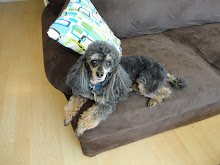It showed up on our schedule as "Calf and Heifer Management", which, judging by the way this block has been going, sounded like another lecture and maybe a demonstration of... something involving calves. (We just finished a midterm Friday. Let's just say it wasn't really coming in on our radar.) So it was a little bit of a shock to read the lab instructions over the weekend and find that they included directions on nerve blocks and how to use a dehorning tool. Sorry, you want us to what? You do realize we've only been vet students for three months, right?
This might not have been quite as scary had Block I not instilled in us the fear of the bovine head. Large animals, owing to their large size, have heads that are mostly filled with air (yes, horse people, you may laugh). Their sinuses are enormous relative to ours to reduce the weight of the head and make it less of a burden for the animal to carry around. Horns are an interesting addition to these air pockets in the cow. They start out as horn buds on young calves, little bony disks just above the skull, and eventually fuse with the skull and the sinus just beneath it. Ideally, calves are de-horned before the disk fuses, to avoid breaching the sinus cavity and inviting lots of nasty infection when the horn is removed. And this is where Block I made us all afraid to ever de-horn a calf. The dehorning tool is basically a self-heating hot iron rod with a cupped end- you press the hot end onto the anesthetized horn bud, hold it for a second, and scoop the little piece off. Simple... except that calves' skulls are rather thin, just like human babies', and holding the iron on too long can occasionally result in cooked calf brain. VERY BAD. Block I liked to frequently remind us of this just in case some of us managed to forget the image of rotisserie brain (with necropsy pictures included).
Actually, it seems like the risk was a little overstated in practice, at least with the style of iron that we used. Or, I assume it was, since 20ish (heavily supervised) first years managed to dehorn 10-15 calves without leaving anyone screaming in pain or neurologically damaged. Still, standing there with a squirming calf between your legs and having a hot iron shoved into your hand to be pressed onto the cute furry animal's head is awkward, no matter how encouraging and wonderful the instructors are. I definitely support dehorning cattle of any type- of course it's not ideal, but do YOU want to handle a 2-ton wad of muscle with 360-degree kicking skills AND horns?- and whenever anyone complains about early-life animal alterations I'm forced to remind them of how we circumcise human males at a day or two old, and they seem to work out (Freud notwithstanding). No living thing has a stress-free existence, and sometimes living indoors, safe from predators, with medical care and constant access to food, comes with a day or so of ouchies for the safety of the handlers. (I haven't met any adult horn-less cows that held a grudge.) Making sure that the process is done well and with as little pain as possible is our job, and it's why I don't mind these kind of awkward tasks- because whether or not I agree with it, I'm glad that they're teaching us to do it right.
And, campylobacter be damned, we did give our calf a hug and some snuggles when we were done. Fuzzy winter calves *are* just about the most adorable baby animals on Earth :)
*EDIT: Technically the procedure we performed was disbudding, the removal of the horn buds, but it was all lumped under the term "dehorning" in our lectures. If you're curious, this is AVMA's position on dehorning/disbudding. I do have to disagree slightly with them on one point... breeding for polled (hornless) cattle is probably not the greatest idea because monkeying with genetics tends to bring a host of other issues. See- the English bulldog, the Manx cat, the Dalmatian, etc. Breeding for one trait just doesn't end well for the breed in question most of the time.
Subscribe to:
Post Comments (Atom)




No comments:
Post a Comment